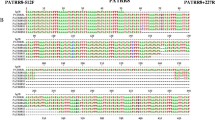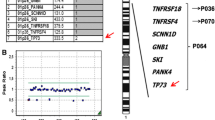Abstract
An inverted duplication with a terminal deletion (inv-dup-del) is one of the complex constitutional structural rearrangements that can occur in a chromosome. Although breakages of dicentric chromosome have been suggested, the precise mechanism of this is yet to be fully understood. In our present study, we investigated the genomic structure of 10 inv-dup-del cases to elucidate this mechanism. Two recurrent 8p inv-dup-del cases harbored a large copy-number-neutral region between the duplication and deletion in common. Although the other non-recurrent cases did not appear to have this copy-number-neutral region, refined sequencing analysis identified that they contained a small intervening region at the junction between the inverted and non-inverted segment. The size of this small intervening region ranged from 1741 to 3728 bp. Combined with a presence of microhomology at the junction, a resolution of the replication fork stalling through template switching within the same replication fork is suggested. We further observed two cases with mosaicism of the dicentric chromosome and various structural rearrangements related to the dicentric chromosome. Refined analysis allowed us to identify different breakpoints on the same chromosome in the same case, implicating multiple rounds of U-type formation and its breakage. From these results, we propose that a replication-based mechanism generates unstable dicentric chromosomes and that their breakage leads to the formation of inv-dup-dels and other related derivative chromosomes.






Similar content being viewed by others
Data availability
All data analyzed during this study are included in this published article.
References
Ballif BC, Yu W, Shaw CA et al (2003) Monosomy 1p36 breakpoint junctions suggest pre-meiotic breakage-fusion-bridge cycles are involved in generating terminal deletions. Hum Mol Genet 12:2153–2165. https://doi.org/10.1093/hmg/ddg231
Bonaglia MC, Giorda R, Massagli A et al (2008) A familial inverted duplication/deletion of 2p25.1–25.3 provides new clues on the genesis of inverted duplications. Eur J Hum Genet 17:179–186. https://doi.org/10.1038/ejhg.2008.160
Chabchoub E, Rodriguez L, Galan E et al (2007) Molecular characterisation of a mosaicism with a complex chromosome rearrangement: evidence for coincident chromosome healing by telomere capture and neo-telomere formation. J Med Genet 44:250–256. https://doi.org/10.1136/jmg.2006.045476
Fan X, Abbott TE, Larson D, Chen K (2014) BreakDancer: Identification of genomic structural variation from paired-end read mapping. Curr Protoc Bioinformatics 45:15.6.1–11. https://doi.org/10.1002/0471250953.bi1506s45
García-Santiago FA, Martínez-Glez V, Santos F et al (2015) Analysis of invdupdel(8p) rearrangement: clinical, cytogenetic and molecular characterization. Am J Med Genet 167A:1018–1025. https://doi.org/10.1002/ajmg.a.36879
Giglio S, Broman KW, Matsumoto N et al (2001) Olfactory receptor-gene clusters, genomic-inversion polymorphisms, and common chromosome rearrangements. Am J Hum Genet 68:874–883. https://doi.org/10.1086/319506
Hermetz KE, Newman S, Conneely KN et al (2014) Large inverted duplications in the human genome form via a fold-back mechanism. PLoS Genet 10:e1004139–e1004214. https://doi.org/10.1371/journal.pgen.1004139
Li H, Durbin R (2010) Fast and accurate long-read alignment with Burrows-Wheeler transform. Bioinformatics 26:589–595. https://doi.org/10.1093/bioinformatics/btp698
Lopes M, Foiani M, Sogo JM (2006) Multiple mechanisms control chromosome integrity after replication fork uncoupling and restart at irreparable UV lesions. Mol Cell 21:15–27. https://doi.org/10.1016/j.molcel.2005.11.015
Noe L, Kucherov G (2005) YASS: enhancing the sensitivity of DNA similarity search. Nucleic Acids Res 33:W540–W543. https://doi.org/10.1093/nar/gki478
Pedurupillay CRJ, Misceo D, Gamage TH et al (2014) Post-zygotic breakage of a dicentric chromosome results in mosaicism for a telocentric 9p marker chromosome in a boy with developmental delay. Gene 533:403–410. https://doi.org/10.1016/j.gene.2013.09.090
Rowe LR, Lee J-Y, Rector L et al (2009) U-type exchange is the most frequent mechanism for inverted duplication with terminal deletion rearrangements. J Med Genet 46:694–702. https://doi.org/10.1136/jmg.2008.065052
Schlade-Bartusiak K, Tucker T, Safavi H et al (2013) Independent post-zygotic breaks of a dicentric chromosome result in mosaicism for an inverted duplication deletion 9p and terminal deletion 9p. Eur J Med Genet 56:229–235. https://doi.org/10.1016/j.ejmg.2013.01.013
Shimokawa O, Kurosawa K, Ida T et al (2004) Molecular characterization of inv dup del(8p): analysis of five cases. Am J Med Genet 128A:133–137. https://doi.org/10.1002/ajmg.a.30063
Soler A, Sánchez A, Carrió A et al (2003) Fetoplacental discrepancy involving structural abnormalities of chromosome 8 detected by prenatal diagnosis. Prenat Diagn 23:319–322. https://doi.org/10.1002/pd.590
Stimpson KM, Song IY, Jauch A et al (2010) Telomere disruption results in non-random formation of de novo dicentric chromosomes involving acrocentric human chromosomes. PLoS Genet 6:e1001061–e1001119. https://doi.org/10.1371/journal.pgen.1001061
Thorvaldsdottir H, Robinson JT, Mesirov JP (2013) Integrative Genomics Viewer (IGV): high-performance genomics data visualization and exploration. Brief Bioinform 14:178–192. https://doi.org/10.1093/bib/bbs017
Weckselblatt B, Rudd MK (2015) Human structural variation: mechanisms of chromosome rearrangements. Trends Genet. https://doi.org/10.1016/j.tig.2015.05.010
Yu S, Graf WD (2010) Telomere capture as a frequent mechanism for stabilization of the terminal chromosomal deletion associated with inverted duplication. Cytogenet Genome Res 129:265–274. https://doi.org/10.1159/000315887
Yu S, Fiedler S, Stegner A, Graf WD (2010) Genomic profile of copy number variants on the short arm of human chromosome 8. Eur J Hum Genet 18:1114–1120. https://doi.org/10.1038/ejhg.2010.66
Zhang F, Carvalho CMB, Lupski JR (2009a) Complex human chromosomal and genomic rearrangements. Trends Genet 25:298–307. https://doi.org/10.1016/j.tig.2009.05.005
Zhang F, Khajavi M, Connolly AM et al (2009b) The DNA replication FoSTeS/MMBIR mechanism can generate genomic, genic and exonic complex rearrangements in humans. Nat Genet 41:849–853. https://doi.org/10.1038/ng.399
Zuffardi O, Bonaglia M, Ciccone R, Giorda R (2009) Inverted duplications deletions: underdiagnosed rearrangements?? Clin Genet 75:505–513. https://doi.org/10.1111/j.1399-0004.2009.01187.x
Acknowledgements
We thank the patients and their families for participating in this study.
Funding
This study was supported by a Grant-in-Aid for Scientific Research from the Ministry of Education, Culture, Sports, Science, and Technology of Japan (17K11259 to T.K., 15H04710 and 24390085 to H.K.) and from the Ministry of Health, Welfare and Labor (16ek0109067h0003 to H.K.).
Author information
Authors and Affiliations
Contributions
TK—participated in the design of the study, carried out the molecular biology work, and drafted the manuscript. HI—participated in the design of the study, carried out the molecular biology work. SuM—participated in the design of the study, carried out the molecular biology work. FS—participated in the design of the study, carried out the molecular biology work. YN—participated in the design of the study, carried out the molecular biology work. YS—participated in the design of the study, carried out the molecular biology work. AK—participated in the design of the study, carried out the molecular biology work. KK—participated in the design of the study, carried out the molecular biology work. SeM—participated in the design of the study. YM—participated in the design of the study. TY—participated in the design of the study. MS—participated in the design of the study. YT—participated in the design of the study, carried out the molecular biology work. SH—participated in the design of the study. TI—participated in the design of the study. MO—participated in the design of the study. HK—Coordinated and conceived the study, being involved in the critical revision of the manuscript for important intellectual content.
Corresponding author
Ethics declarations
Conflict of interest
The authors declare no competing interests.
Ethical approval
This study was approved by the Ethical Review Board for Human Genome Studies at Fujita Health University. The written informed consent was obtained from patients. All experiments were carried out in accordance with the relevant guidelines and regulations.
Informed consent
We have obtained consent to participate in the study. We have obtained consent to publication in the study.
Additional information
Publisher's Note
Springer Nature remains neutral with regard to jurisdictional claims in published maps and institutional affiliations.
Rights and permissions
About this article
Cite this article
Kato, T., Inagaki, H., Miyai, S. et al. The involvement of U-type dicentric chromosomes in the formation of terminal deletions with or without adjacent inverted duplications. Hum Genet 139, 1417–1427 (2020). https://doi.org/10.1007/s00439-020-02186-8
Received:
Accepted:
Published:
Issue Date:
DOI: https://doi.org/10.1007/s00439-020-02186-8




